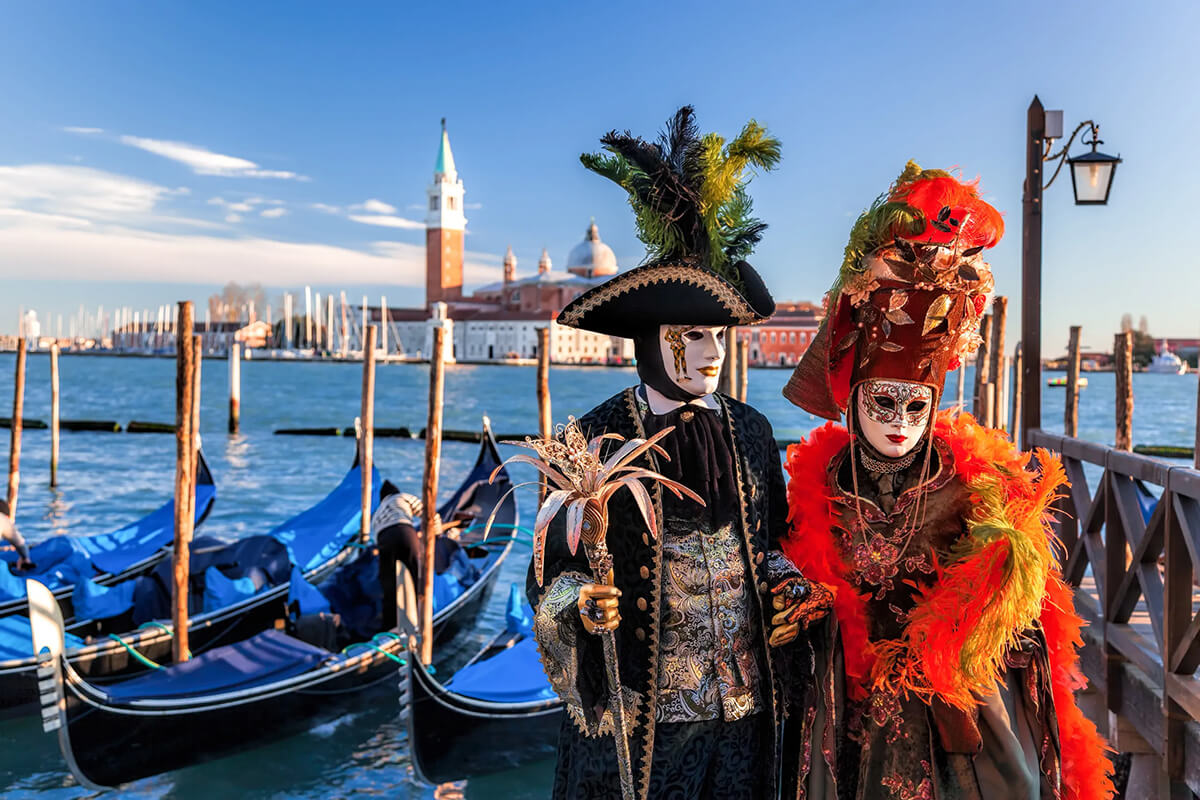Italy is a country steeped in rich history, culture, and tradition, and nowhere is this more apparent than in its festivals and celebrations. Whether it's a grand religious event, a lively regional festival, or a celebration of food, art, and music, Italian festivals are a reflection of the country's deep-rooted love for community, family, and the joy of life. These celebrations not only highlight Italy’s rich cultural heritage but also offer a glimpse into the vibrant spirit of the Italian people.
In this blog post, we’ll explore some of the most famous and beloved Italian festivals, what makes them unique, and how they bring people together in ways that are as much about tradition as they are about sheer enjoyment.
1. Carnival of Venice (Carnevale di Venezia)
Arguably one of the most famous festivals in Italy, the Carnival of Venice is a spectacle of masks, elaborate costumes, and centuries-old traditions. Celebrated in the weeks leading up to Lent, this festival is an extravagant display of artistic expression and mystery. Visitors from all over the world flock to Venice to participate in the festivities, which include masquerade balls, street performances, and parades.
The Carnival of Venice dates back to the 12th century and was initially a celebration of the Venice Republic's wealth and power. The masks, which are a signature feature of the festival, were traditionally worn to allow people from all social classes to mingle without fear of judgment or discrimination. Today, the festival retains its magical, otherworldly charm, and the sight of gondolas gliding through the canals with masked revelers is truly a once-in-a-lifetime experience.
Must-See Events:
- Volo dell’Angelo: The “Flight of the Angel,” a spectacular event where a performer dressed as an angel soars from the top of the bell tower in Piazza San Marco to the crowd below.
- Masquerade Balls: Elegant, exclusive parties where guests wear intricate masks and gowns, evoking the spirit of Venice’s aristocracy.
2. La Festa della Repubblica (Republic Day)
Held annually on June 2nd, La Festa della Repubblica is Italy’s national day, marking the country’s transition from a monarchy to a republic in 1946. This important day commemorates the results of a referendum that ended the rule of the Italian monarchy and established the Italian Republic. The day is celebrated with patriotism, public events, and ceremonial parades across Italy, but the most prominent celebrations take place in Rome.
The main event is a grand military parade held in the heart of Rome, where soldiers, air force jets, and military vehicles march through the streets. It’s a day of national pride, with flag-raising ceremonies, concerts, and performances. For Italians, it’s a time to reflect on the country’s history and the journey it’s made since World War II.
Must-See Events:
- The Military Parade in Rome: A powerful display of Italy’s armed forces, featuring marching bands, air shows, and tanks.
- The Wreath-Laying Ceremony at the Altare della Patria: A solemn ceremony where the Italian president places a wreath at the Tomb of the Unknown Soldier.
3. Palio di Siena
The Palio di Siena is one of Italy's oldest and most thrilling festivals. Held twice a year, on July 2nd and August 16th, in the historic city of Siena, this medieval horse race draws huge crowds from around the world. What makes the Palio so special is not just the race itself, but the centuries-old rivalry between the city's districts, known as contrade. Each contrada has its own mascot, colors, and traditions, and their pride is on the line during the race.
The race takes place in the main square, Piazza del Campo, and is an intense, fast-paced contest where riders race bareback around the narrow, cobbled streets of Siena. The festival leading up to the race is filled with religious processions, music, and street parties, and the entire city gets involved in the celebrations.
Must-See Events:
- The Palio Race: The high-stakes horse race itself, where riders race for glory and honor.
- The Contrada Parades: Colorful processions with participants wearing traditional medieval costumes to celebrate their contrada’s history.
4. Ferragosto
Celebrated on August 15th, Ferragosto is one of Italy's most beloved national holidays, marking the peak of summer. It is a day for relaxation, food, and family gatherings, and it’s traditionally a time when Italians take their summer vacation. Originally a Roman holiday dedicated to the harvest and relaxation, Ferragosto has evolved into a day for Italians to enjoy the beauty of summer, whether by the sea, in the mountains, or at home with loved ones.
While many Italians take the entire month of August off for vacation, Ferragosto itself is marked by feasts, picnics, and outdoor celebrations. Many towns hold fireworks displays, and some cities host traditional events, such as the famous Palio del Golfo boat race in La Spezia or the horse race in Palio di Siena, both of which are held on Ferragosto.
Must-See Events:
- Fireworks and Festivals: Coastal towns and cities light up the sky with fireworks, while small towns host folk festivals and dances.
- The Feast of Assumption: Many towns hold religious processions celebrating the Assumption of Mary into heaven, with elaborate decorations and costumes.
5. La Taranta (La Notte della Taranta)
La Taranta, also known as La Notte della Taranta, is a traditional folk music festival that takes place in the Puglia region, usually in late August. This festival celebrates the folk music of Salento, particularly the pizzica, a lively and rhythmic dance that originated as a folk remedy for those bitten by the tarantula spider (hence the name “taranta”).
Over several days, the town of Melpignano becomes the epicenter of the festival, with performances by musicians from all over Italy and beyond. The main event is the night-long concert in Piazza Sant'Oronzo, where thousands of people gather to dance the pizzica under the stars. The music, with its energetic rhythms, hypnotic beats, and passionate lyrics, fills the streets, and the festival draws music lovers from all over the world.
Must-See Events:
- Pizzica Dance: The traditional dance, which involves intense, almost trance-like movements, performed by couples or groups.
- The Grand Concert: A night-long concert featuring folk music from the Salento region and beyond.
6. Giro d’Italia
For sports enthusiasts, the Giro d’Italia is one of the world’s most prestigious cycling races, held annually in May. While it’s not a festival in the traditional sense, the Giro has become a celebration of Italy’s love for cycling and the outdoors. The race takes participants on a grueling tour through Italy’s most scenic landscapes, from the rolling hills of Tuscany to the mountainous terrain of the Dolomites.
During the race, cities and towns across Italy throw festive gatherings and parties to cheer on the cyclists. Locals and tourists alike line the streets to witness the race firsthand, making the Giro not just a sporting event, but a national celebration of Italian culture and athleticism.
Must-See Events:
- The Stage Finish: Each day of the Giro ends with the thrilling sprint to the finish, often in a city center surrounded by cheering crowds.
- Fan Festivals: Local festivals and celebrations in towns along the Giro route.
7. Festival of San Gennaro
San Gennaro is the patron saint of Naples, and his festival, held every September, is one of the most important celebrations in the city. The highlight of this event is the miracle of San Gennaro, a religious ritual where the blood of the saint, preserved in a vial, is said to liquefy—signifying the saint’s blessing for the city. While the religious ceremony is solemn, the surrounding festivities are full of joy, music, food, and dance, as Neapolitans celebrate their saint and their rich heritage.
Must-See Events:
- The Miracle of San Gennaro: The religious ritual in the Naples Cathedral, where the blood of the saint is presented to the public.
- The Feast: A lively street festival with food, music, and parades.
Conclusion: Italy’s Festivals as a Celebration of Life
From the artistic beauty of Venice’s Carnival to the lively rhythms of La Taranta in Puglia, Italian festivals offer a window into the heart and soul of Italian culture. They are a vibrant mix of history, religion, art, food, and music, all blending together to create experiences that are as unforgettable as they are unique.
These celebrations bring people together, whether they’re honoring saints, celebrating seasons, or simply reveling in the joy of life. Attending an Italian festival isn’t just about witnessing a spectacle—it’s about immersing yourself in a culture that celebrates connection, tradition, and, above all, living life to its fullest.


